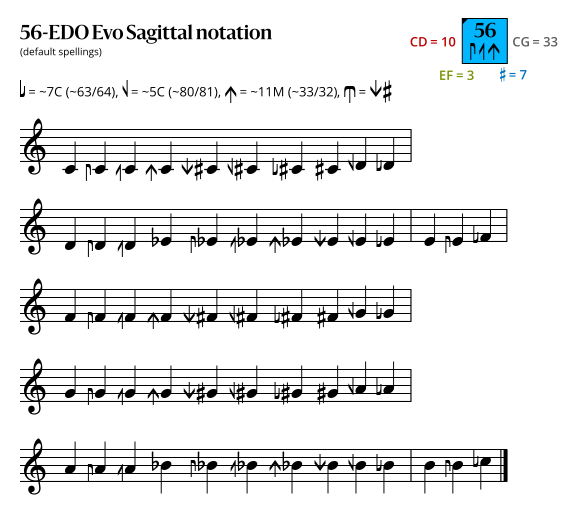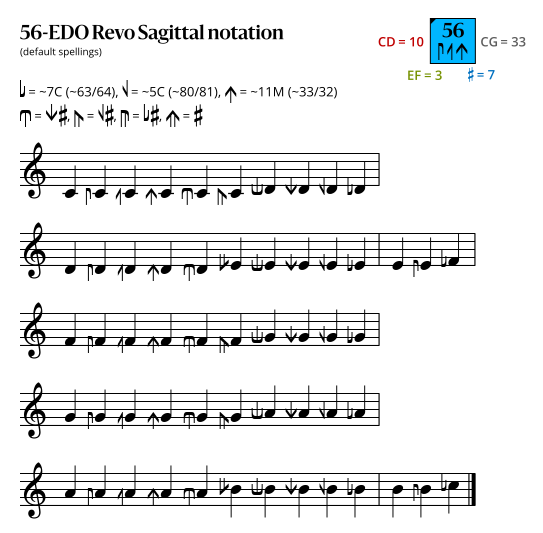56edo
| ← 55edo | 56edo | 57edo → |
56 equal divisions of the octave (abbreviated 56edo or 56ed2), also called 56-tone equal temperament (56tet) or 56 equal temperament (56et) when viewed under a regular temperament perspective, is the tuning system that divides the octave into 56 equal parts of about 21.4 ¢ each. Each step represents a frequency ratio of 21/56, or the 56th root of 2.
Theory
56edo shares its near perfect quality of classical major third with 28edo, which it doubles, while also adding a superpythagorean 5th that is a convergent towards the bronze metallic mean, following 17edo and preceding 185edo. Because it contains 28edo's major third and also has a step size very close to the syntonic comma, 56edo contains very accurate approximations of both the classic major third 5/4 and the Pythagorean major third 81/64. Unfortunately, this "Pythagorean major third" is not the major third as is stacked by fifths in 56edo.
56edo can be used to tune hemithirds, superkleismic, sycamore and keen temperaments, and using ⟨56 89 130 158] (56d) as the equal temperament val, for pajara. It provides the optimal patent val for 7-, 11- and 13-limit sycamore, and the 11-limit 56d val is close to the POTE tuning for 11-limit pajara.
Prime harmonics
| Harmonic | 2 | 3 | 5 | 7 | 11 | 13 | 17 | 19 | 23 | 29 | 31 | |
|---|---|---|---|---|---|---|---|---|---|---|---|---|
| Error | Absolute (¢) | +0.00 | +5.19 | -0.60 | -4.54 | +5.82 | -4.81 | +2.19 | +2.49 | -6.85 | -1.01 | -9.32 |
| Relative (%) | +0.0 | +24.2 | -2.8 | -21.2 | +27.2 | -22.5 | +10.2 | +11.6 | -31.9 | -4.7 | -43.5 | |
| Steps (reduced) |
56 (0) |
89 (33) |
130 (18) |
157 (45) |
194 (26) |
207 (39) |
229 (5) |
238 (14) |
253 (29) |
272 (48) |
277 (53) | |
Subsets and supersets
Since 56 factors into 23 × 7, 56edo has subset edos 2, 4, 7, 8, 14, 28.
One step of 56edo is the closest direct approximation to the syntonic comma, 81/80, with the unrounded value being 55.7976. Barium temperament realizes this proximity through regular temperament theory, and is supported by notable edos like 224edo, 1848edo, and 2520edo, which is a highly composite edo.
Intervals
| # | Cents | Approximate ratios* | Ups and downs notation |
|---|---|---|---|
| 0 | 0.0 | 1/1 | D |
| 1 | 21.4 | 49/48, 55/54, 56/55, 64/63 | ^D, vvE♭ |
| 2 | 42.9 | 28/27, 40/39, 45/44, 50/49, 81/80 | ^^D, vE♭ |
| 3 | 64.3 | 25/24, 36/35, 33/32 | ^3D, E♭ |
| 4 | 85.7 | 19/18, 20/19, 21/20, 22/21 | v3D♯, ^E♭ |
| 5 | 107.1 | 16/15, 17/16, 18/17 | vvD♯, ^^E♭ |
| 6 | 128.6 | 15/14, 13/12, 14/13 | vD♯, ^3E♭ |
| 7 | 150.0 | 12/11 | D♯, v3E |
| 8 | 171.4 | 10/9, 11/10, 21/19 | ^D♯, vvE |
| 9 | 192.9 | 19/17, 28/25 | ^^D♯, vE |
| 10 | 214.3 | 9/8, 17/15 | E |
| 11 | 235.7 | 8/7 | ^E, vvF |
| 12 | 257.1 | 7/6 | ^^E, vF |
| 13 | 278.6 | 13/11, 20/17 | F |
| 14 | 300.0 | 19/16, 25/21 | ^F, vvG♭ |
| 15 | 321.4 | 6/5 | ^^F, vG♭ |
| 16 | 342.9 | 11/9, 17/14 | ^3F, G♭ |
| 17 | 364.3 | 16/13, 21/17, 26/21 | v3F♯, ^G♭ |
| 18 | 385.7 | 5/4 | vvF♯, ^^G♭ |
| 19 | 407.1 | 14/11, 19/12, 24/19 | vF♯, ^3G♭ |
| 20 | 428.6 | 32/25, 33/26 | F♯, v3G |
| 21 | 450.0 | 9/7, 13/10 | ^F♯, vvG |
| 22 | 471.4 | 17/13, 21/16 | ^^F♯, vG |
| 23 | 492.9 | 4/3 | G |
| 24 | 514.3 | 35/26 | ^G, vvA♭ |
| 25 | 535.7 | 15/11, 19/14, 26/19, 27/20 | ^^G, vA♭ |
| 26 | 557.1 | 11/8 | ^3G, A♭ |
| 27 | 578.6 | 7/5 | v3G♯, ^A♭ |
| 28 | 600.0 | 17/12, 24/17 | vvG♯, ^^A♭ |
| … | … | … | … |
* The following table assumes the 19-limit patent val; other approaches are possible. Inconsistent intervals are marked in italics.
Notation
Ups and downs notation
56edo can be notated using ups and downs. Trup is equivalent to quudsharp, trudsharp is equivalent to quup, etc.
| Step offset | 0 | 1 | 2 | 3 | 4 | 5 | 6 | 7 | 8 | 9 | 10 | 11 | 12 | 13 | 14 |
|---|---|---|---|---|---|---|---|---|---|---|---|---|---|---|---|
| Sharp symbol | |
||||||||||||||
| Flat symbol |
Alternatively, sharps and flats with arrows borrowed from Helmholtz–Ellis notation can be used:
| Step offset | 0 | 1 | 2 | 3 | 4 | 5 | 6 | 7 | 8 | 9 | 10 | 11 | 12 | 13 | 14 | 15 | 16 | 17 |
|---|---|---|---|---|---|---|---|---|---|---|---|---|---|---|---|---|---|---|
| Sharp symbol | |
|||||||||||||||||
| Flat symbol |
Sagittal notation
This notation uses the same sagittal sequence as 63-EDO.
Evo flavor

Revo flavor

Approximation to JI
The following tables show how 15-odd-limit intervals are represented in 56edo. Prime harmonics are in bold; inconsistent intervals are in italics.
| Interval and complement | Error (abs, ¢) | Error (rel, %) |
|---|---|---|
| 1/1, 2/1 | 0.000 | 0.0 |
| 13/7, 14/13 | 0.273 | 1.3 |
| 5/4, 8/5 | 0.599 | 2.8 |
| 11/6, 12/11 | 0.637 | 3.0 |
| 15/11, 22/15 | 1.236 | 5.8 |
| 7/5, 10/7 | 3.941 | 18.4 |
| 13/10, 20/13 | 4.214 | 19.7 |
| 7/4, 8/7 | 4.540 | 21.2 |
| 11/9, 18/11 | 4.551 | 21.2 |
| 15/8, 16/15 | 4.588 | 21.4 |
| 13/8, 16/13 | 4.813 | 22.5 |
| 3/2, 4/3 | 5.188 | 24.2 |
| 5/3, 6/5 | 5.787 | 27.0 |
| 11/8, 16/11 | 5.825 | 27.2 |
| 13/9, 18/13 | 6.239 | 29.1 |
| 11/10, 20/11 | 6.424 | 30.0 |
| 9/7, 14/9 | 6.513 | 30.4 |
| 15/14, 28/15 | 9.129 | 42.6 |
| 15/13, 26/15 | 9.402 | 43.9 |
| 7/6, 12/7 | 9.728 | 45.4 |
| 13/12, 24/13 | 10.001 | 46.7 |
| 11/7, 14/11 | 10.365 | 48.4 |
| 9/8, 16/9 | 10.376 | 48.4 |
| 9/5, 10/9 | 10.453 | 48.8 |
| 13/11, 22/13 | 10.638 | 49.6 |
| Interval and complement | Error (abs, ¢) | Error (rel, %) |
|---|---|---|
| 1/1, 2/1 | 0.000 | 0.0 |
| 13/7, 14/13 | 0.273 | 1.3 |
| 5/4, 8/5 | 0.599 | 2.8 |
| 11/6, 12/11 | 0.637 | 3.0 |
| 15/11, 22/15 | 1.236 | 5.8 |
| 7/5, 10/7 | 3.941 | 18.4 |
| 13/10, 20/13 | 4.214 | 19.7 |
| 7/4, 8/7 | 4.540 | 21.2 |
| 11/9, 18/11 | 4.551 | 21.2 |
| 15/8, 16/15 | 4.588 | 21.4 |
| 13/8, 16/13 | 4.813 | 22.5 |
| 3/2, 4/3 | 5.188 | 24.2 |
| 5/3, 6/5 | 5.787 | 27.0 |
| 11/8, 16/11 | 5.825 | 27.2 |
| 11/10, 20/11 | 6.424 | 30.0 |
| 15/14, 28/15 | 9.129 | 42.6 |
| 15/13, 26/15 | 9.402 | 43.9 |
| 7/6, 12/7 | 9.728 | 45.4 |
| 13/12, 24/13 | 10.001 | 46.7 |
| 11/7, 14/11 | 10.365 | 48.4 |
| 9/8, 16/9 | 10.376 | 48.4 |
| 13/11, 22/13 | 10.638 | 49.6 |
| 9/5, 10/9 | 10.975 | 51.2 |
| 9/7, 14/9 | 14.916 | 69.6 |
| 13/9, 18/13 | 15.189 | 70.9 |
Zeta peak index
| Tuning | Strength | Octave (cents) | Integer limit | |||||||
|---|---|---|---|---|---|---|---|---|---|---|
| ZPI | Steps per 8ve |
Step size (cents) |
Height | Integral | Gap | Size | Stretch | Consistent | Distinct | |
| Tempered | Pure | |||||||||
| 276zpi | 56.00834 | 21.425381 | 6.063216 | 6.023344 | 0.931117 | 14.804703 | 1199.821313 | −0.178687 | 8 | 8 |
Regular temperament properties
| Subgroup | Comma list | Mapping | Optimal 8ve stretch (¢) |
Tuning error | |
|---|---|---|---|---|---|
| Absolute (¢) | Relative (%) | ||||
| 2.3 | [89 -56⟩ | [⟨56 89]] | −1.64 | 1.63 | 7.64 |
| 2.3.5 | 2048/2025, 1953125/1889568 | [⟨56 89 130]] | −1.01 | 1.61 | 7.50 |
| 2.3.5.7 | 686/675, 875/864, 1029/1024 | [⟨56 89 130 157]] | −0.352 | 1.80 | 8.38 |
| 2.3.5.7.11 | 100/99, 245/242, 385/384, 686/675 | [⟨56 89 130 157 194]] | −0.618 | 1.69 | 7.90 |
| 2.3.5.7.11.13 | 91/90, 100/99, 169/168, 245/242, 385/384 | [⟨56 89 130 157 194 207]] | −0.299 | 1.70 | 7.95 |
Rank-2 temperaments
| Periods per 8ve |
Generator* | Cents* | Associated ratio* |
Temperament |
|---|---|---|---|---|
| 1 | 3\56 | 64.29 | 25/24 | Sycamore |
| 1 | 9\56 | 192.86 | 28/25 | Hemithirds |
| 1 | 11\56 | 235.71 | 8/7 | Slendric |
| 1 | 15\56 | 321.43 | 6/5 | Superkleismic |
| 1 | 25\56 | 535.71 | 15/11 | Maquila (56d) / maquiloid (56) |
| 2 | 11\56 | 235.71 | 8/7 | Echidnic |
| 2 | 23\56 (5\56) |
492.86 (107.14) |
4/3 (17/16) |
Keen / keenic |
| 4 | 23\56 (5\56) |
492.86 (107.14) |
4/3 (17/16) |
Bidia (7-limit) |
| 7 | 23\56 (1\56) |
492.86 (21.43) |
4/3 (250/243) |
Sevond |
* Octave-reduced form, reduced to the first half-octave, and minimal form in parentheses if distinct
Scales
- Supra7
- Supra12
- Subsets of echidnic[16] (6u8d):
- Frankincense (this is the original/default tuning): 364.3 - 492.9 - 707.1 - 835.7 - 1200.0
- Quasi-equipentatonic: 257.1 - 492.9 - 707.1 - 964.3 - 1200.0
- Sakura-like scale containing phi: 107.1 - 492.9 - 707.1 - 835.7 - 1200.0
- Subsets of sevond[14]
- Evened minor pentatonic (approximated from 72edo): 321.4 - 492.9 - 685.7 - 1028.6 - 1200.0
Music
- 56edo (2023)
- Prelude & Fugue in Pajara (2020) – in pajara, 56edo tuning
- Mirror Canon in F (2020)
- Canon 3-in-1 on a Ground (2020)

































